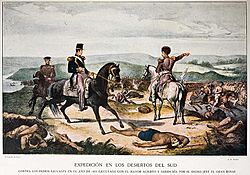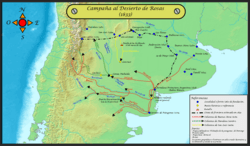Desert Campaign (1833–1834) facts for kids
Quick facts for kids Desert Campaign |
|
|---|---|
 Juan Manuel de Rosas, a key leader |
|
| Location | Argentine Pampas |
| Planned by | Juan Manuel de Rosas |
| Objective | End malones and aid in territorial expansion |
| Date | 1833–1834 |
| Executed by | Juan Manuel de Rosas, Facundo Quiroga, Félix Aldao, Ruiz Huidobro |
| Outcome | Argentine victory |
| Casualties | 3,200 aboriginal people |
The Desert Campaign (1833–1834) was a military operation in Argentina. It was led by Juan Manuel de Rosas against the native groups living in the southern Pampas and northern Patagonia regions. This campaign happened before a later, larger one called the Conquest of the Desert in the 1870s and 1880s.
Contents
Why the Campaign Happened
Juan Manuel de Rosas finished his first time as governor of Buenos Aires in 1832. He had won against a group called the Unitarian League in Argentina. When the Argentine Civil Wars calmed down, Rosas started to focus on protecting the borders from native groups.
Juan Ramón Balcarce became governor after Rosas. He allowed Rosas to start this military campaign. This happened even though some people suggested that Rosas should not be given permission to do it.
The Campaign in Action
The land itself made the military campaign very difficult. There were no European towns along the path Rosas's army took. His soldiers had to carry all their supplies from Buenos Aires. Because the area was so far away, messages had to be sent through many messengers to reach Buenos Aires. Also, Rosas needed a lot of horses. These were hard to find because of the ongoing civil wars in Argentina.
The campaign covered a huge area, from the Atlantic Ocean to the Andes mountains. It involved attacks from several different directions.
- Félix Aldao from the Mendoza Province attacked the Mapuche people in the south of his province and in Neuquen.
- Ruiz Huidobro, working under Facundo Quiroga, faced the Ranqueles in San Luis and Córdoba.
- Juan Manuel de Rosas himself led the part of the campaign in the Buenos Aires province.
Even though Rosas planned the whole campaign, Facundo Quiroga was the main commander on the battlefield. It was hoped that Chile would send military help. However, Chile could not, because of a rebellion and attempts to kill their leader, Diego Portales. Rosas's group left Buenos Aires on March 22, 1833.
Rosas's Strategy with Native Groups
Rosas divided the native populations into three types: friends, allies, and enemies.
- "Friends" were allowed to live inside Buenos Aires province. Some even lived on Rosas's own farm.
- "Allies" were allowed to keep their own lands and stay independent. Rosas gave both these groups cattle and other goods.
- Rosas personally met with the caciques (chiefs). He learned the Puelche language. Later, he even wrote a book called La gramática y diccionario de la lengua Pampa (which means "Grammar and Dictionary of the Pampa Language").
The "enemies" group included the Ranquel and Mapuche people. They refused to talk with the Spanish colonial government. Instead, they attacked rural villages and farms in raids known as malones. The Ranquels were led by a famous warrior named Yanquetruz. He was very good at quick hit-and-run attacks.
Rosas led the military actions against these "enemies." He built on earlier campaigns by leaders like Martín Rodríguez and Bernardino Rivadavia. Because of this, Rosas was able to go much deeper into native lands than previous leaders. He destroyed several native settlements. Rosas later claimed that his army killed 3,200 native people during the campaign. He also said they captured 1,200 prisoners and rescued 1,000 captives.
What Happened Next
Rosas's campaign brought a short time of peace with the native communities. It also stopped the malones for a while. This peace lasted until Rosas was removed from power at the Battle of Caseros.
Even though they had been fighting Argentine forces since 1821, some native groups launched counter-attacks during the Battle of Caseros. However, they continued to lose control of their lands. They slowly moved further south. The final defeat of the native peoples happened during the Conquest of the Desert. This later campaign was led by Julio Argentino Roca.
See also
 In Spanish: Campaña de Rosas al Desierto para niños
In Spanish: Campaña de Rosas al Desierto para niños



